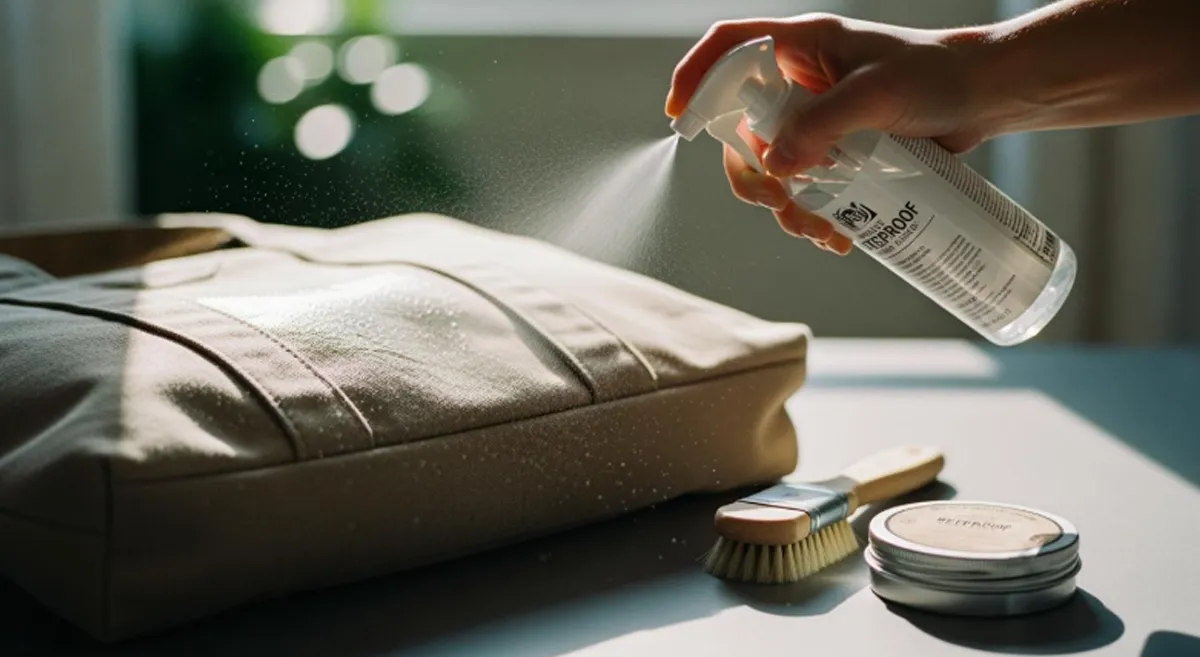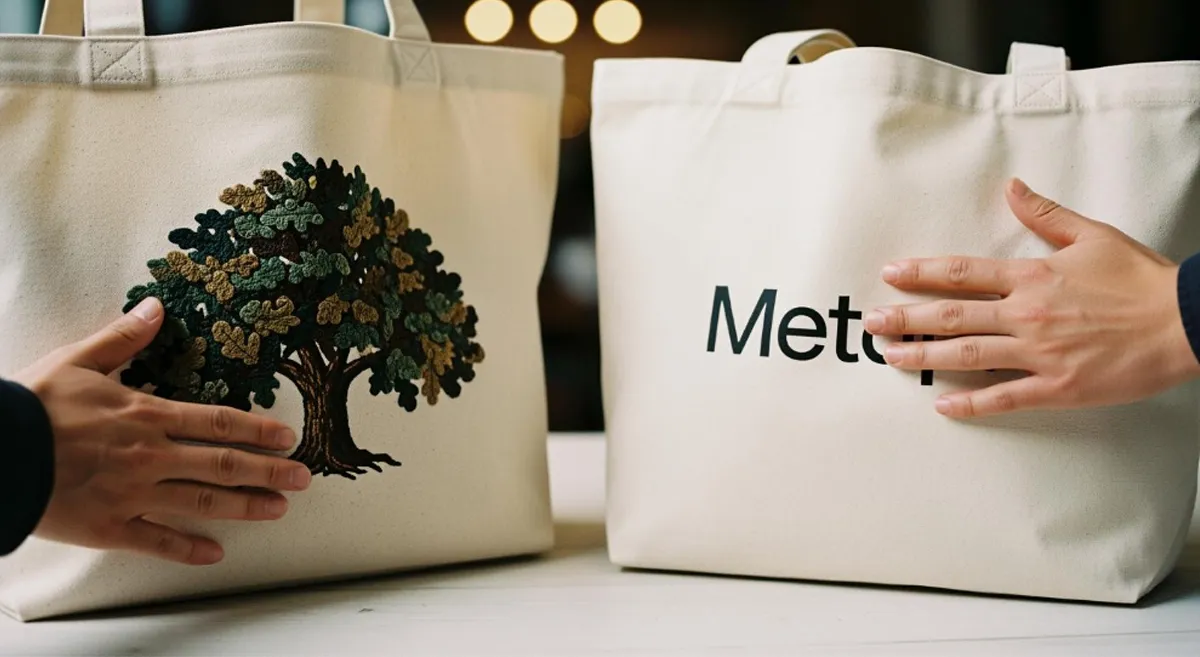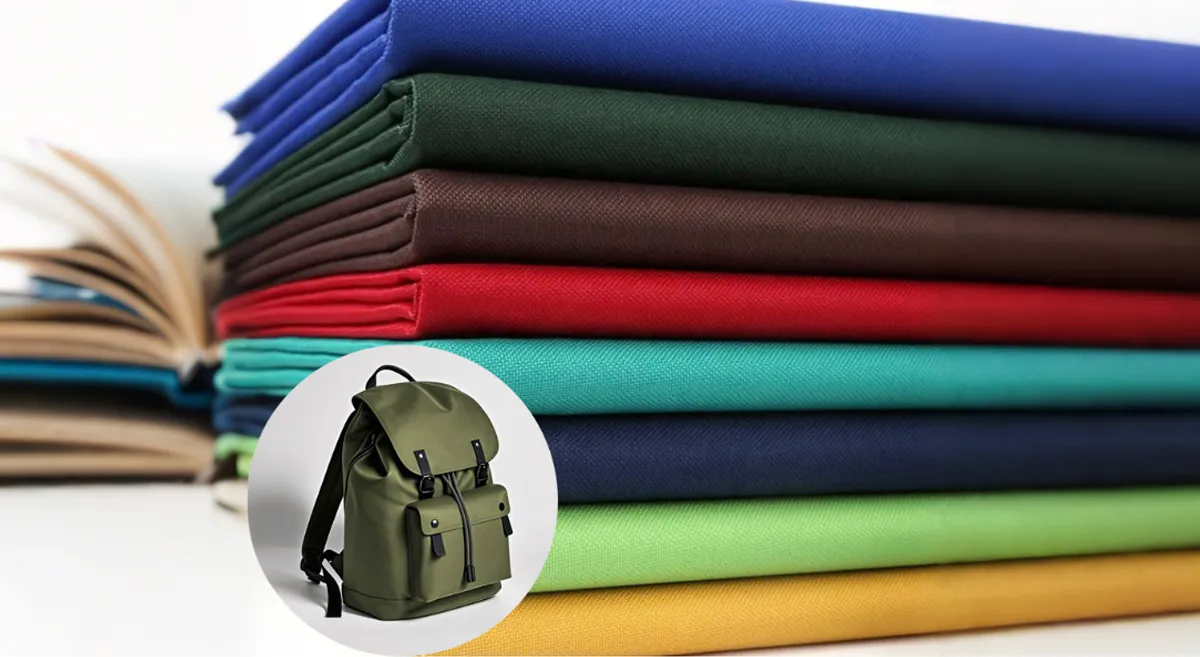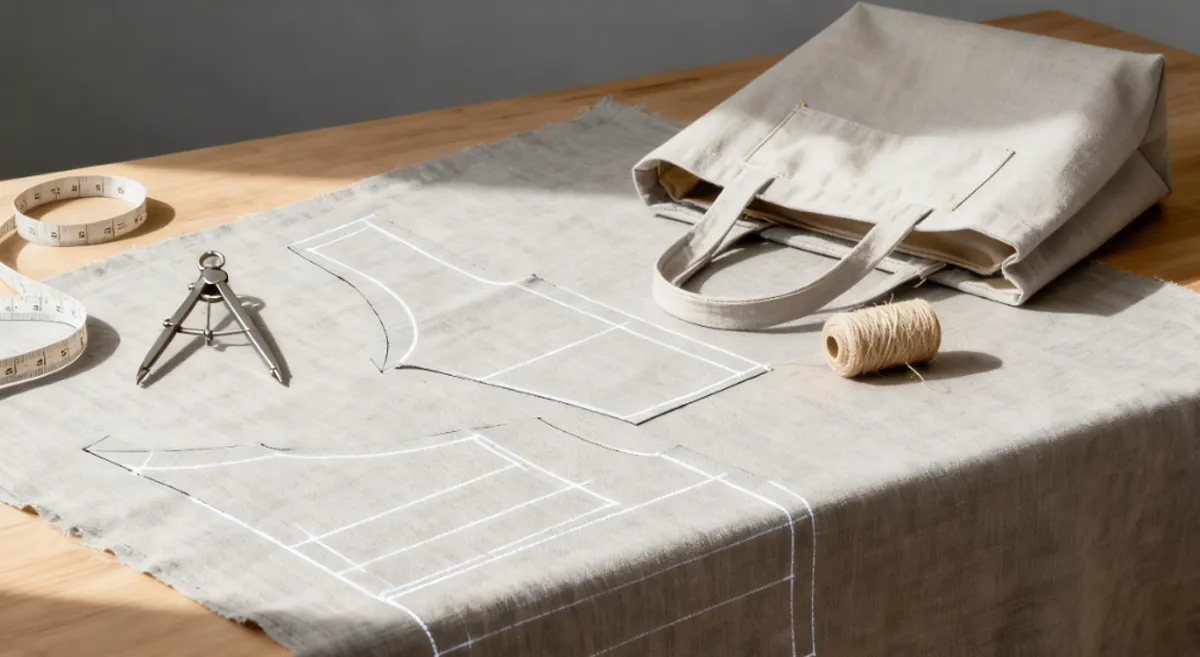
If you want to sew your own tote bag, you probably wonder, How Much Fabric Do You Need for a Tote Bag? For a basic tote measuring about 14 inches wide, 16 inches tall, and 4 inches deep, you usually need between 0.75 and 1 yard of 54-inch wide fabric. This covers the bag and handles. Tote bags come in all shapes and sizes, though, so here’s a quick guide:
| Size Category | Dimensions (W x H x D inches) | Estimated Fabric Needed (44/45″ wide) |
|---|---|---|
| Small | 12 x 14 x 4 | ~ 1 yard |
| Medium | 14 x 16 x 5 | ~ 1.25 yards |
| Large | 15 x 18 x 8 | ~ 1.5 yards |
Want lining, pockets, or extra-long straps? You might need a bit more fabric than listed above.
Key Takeaways
- For a regular tote bag, you need about 0.75 to 1 yard of fabric. The fabric should be 54 inches wide.
- The size of your bag changes how much fabric you need. Small bags need about 1 yard. Medium bags need about 1.25 yards. Large bags need up to 1.5 yards.
- If you add lining or pockets, you need more fabric. Plan for 0.5 extra yards for lining. Plan for 0.25 extra yards for pockets.
- Always measure your bag’s size carefully. Check the width, height, and depth. This helps you know how much fabric to use.
- Wider fabric means you need less fabric. Fabric that is 54 inches wide needs less than 44-inch wide fabric. Pick the best width for your design.
- Wash your fabric before you sew it. This stops it from shrinking later. Your tote will stay the right size.
- Use leftover fabric for pockets or handles. You can also use scraps for other details. This helps you waste less and makes your tote special.
- Plan how you will cut your fabric. Arrange the pieces to use as much fabric as possible. This helps you waste less fabric.
How Much Fabric Do You Need for a Tote Bag
Standard Tote Bag Size
When you start planning your tote bag project, you probably ask yourself, how much fabric do you need for a tote bag? Most sewing experts agree that a standard tote bag size measures about 14 inches wide, 16 inches tall, and 4 inches deep. For this size, you need between 0.75 and 1 yard of 54-inch wide fabric. This amount of fabric gives you enough material for the main body and basic handles.
Here’s a quick look at the average fabric yardage for a standard tote bag:
| Bag Size (W x H x D) | Fabric Needed (54″ wide) |
|---|---|
| 14″ x 16″ x 4″ (standard) | 0.75–1 yard |
You can use this as a starting point for most everyday tote bag projects.
Quick Reference by Bag Size
You might want a smaller or larger tote, depending on your needs. How much fabric do you need for a tote bag changes with the size. Let’s break it down so you can see the difference at a glance.
| Size Category | Dimensions (inches) | Typical Use |
|---|---|---|
| Small | 12” x 12” | Light day out, carrying essentials like wallet and phone. |
| Medium | 15” x 14” | Everyday use, carrying essentials like water bottle and small electronics. |
| Large | 18” x 15” | Carrying heavier loads like gym gear or groceries. |
| Extra-Large | 20” x 16” | Carrying multiple items like beach gear or travel essentials. |
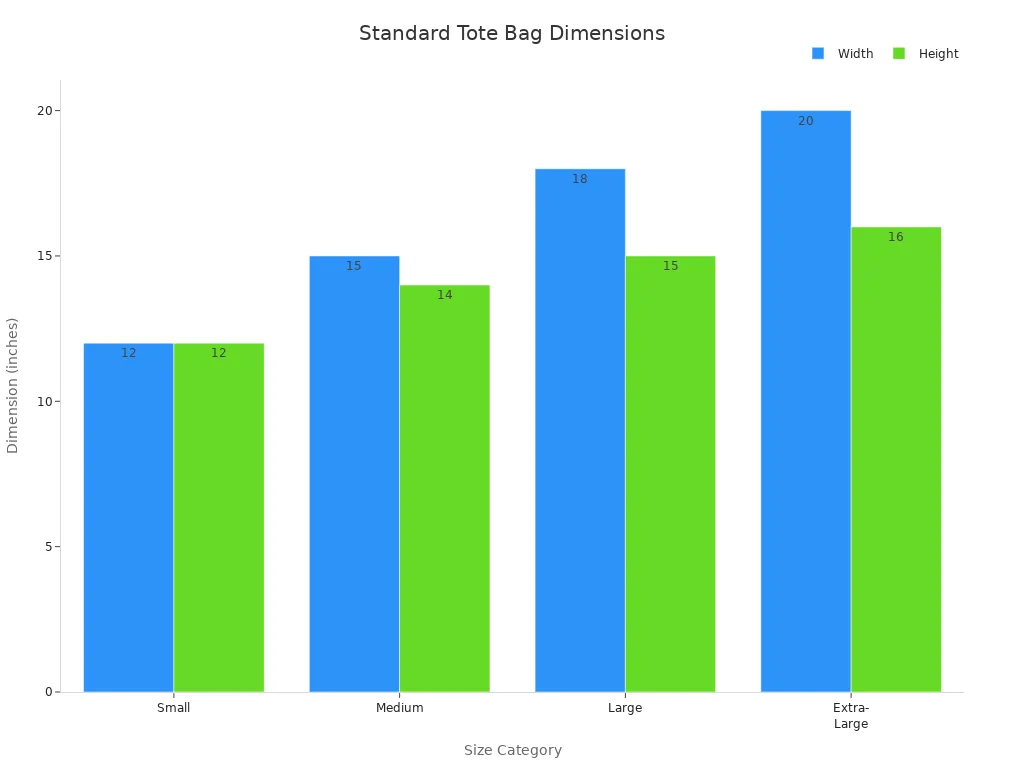
Here’s a quick reference for how much fabric you need for each size:
- Small tote (12” x 12”): about 1 yard of fabric
- Medium tote (15” x 14”): about 1.25 yards of fabric
- Large tote (18” x 15”): about 1.5 yards of fabric
- Extra-large tote (20” x 16”): up to 2 yards of fabric
If you want to make a standard tote bag, you can stick with 0.75 to 1 yard of fabric. For bigger bags, you need more yards of fabric.
Lining, Pockets, and Handles
You might want to add a lining, pockets, or longer handles to your tote. These features make your bag stronger and more useful, but they also change how much fabric you need for a tote bag.
Tip: Always buy a little extra fabric if you plan to add special features. It’s better to have a bit left over than to run short.
Here’s what you should consider:
- If you add a lining, you need an extra 0.5 yards of fabric.
- For pockets, you should add at least 0.25 yards of fabric.
- Handles usually use scraps, but if you want extra-long or padded handles, add 0.25 yards of fabric.
Let’s compare lined and unlined tote bags:
| Feature | Lined Handbag | Unlined Handbag |
|---|---|---|
| Durability (Interior) | High – protected from abrasion and spills | Low to moderate – exposed to direct wear |
| Weight | Slightly heavier due to extra fabric | Lighter and more flexible |
| Maintenance | Easier to wipe clean internally | Requires regular conditioning and spot care |
If you want a sturdy, easy-to-clean bag, go for a lined design. You will need more yards of fabric, but your tote will last longer.
So, how much fabric do you need for a tote bag? Start with the standard tote bag size and adjust the amount of fabric based on your features. Always check your measurements and buy a little extra to be safe.
Factors Affecting How Much Fabric
Bag Dimensions
When you plan your tote bag, the size you choose makes a big difference in how much fabric you need. Bigger bags use more fabric, while smaller bags use less. You should measure the width, height, and depth of your bag before you buy fabric. If you want a deep bag for groceries or books, you will need extra material for the sides and bottom. A flat tote for light items uses less fabric.
Here are some things that affect fabric needs:
- The length and width of your bag panels.
- The depth or gusset you add for extra space.
- The size and number of pockets you want.
You also need to think about the type of fabric. Some materials are thicker or heavier, so you might need more or less depending on the weight and weave. For example:
- Material composition: Cotton, canvas, denim, and linen all have different weights.
- Weave structure: Tightly woven fabrics are stronger and may need less layering.
- GSM (grams per square meter): Heavier fabrics (higher GSM) make sturdy bags but can affect how much you need.
If you want a bag that holds heavy items, choose a thicker fabric. If you want a lightweight tote, pick a thinner material.
Fabric Width
Fabric comes in different widths, and this changes how much you need for your tote bag. Most fabric bolts are 44-45 inches or 54 inches wide. Wider fabric lets you cut bigger pieces, so you use less yardage. If you use a narrow fabric, you need more yards to get the same size bag.
Let’s look at how fabric width affects your project:
- If you use a 36-inch wide fabric, you will need more yards than if you use a 58/60-inch wide fabric.
- A 54-inch wide fabric usually means you need less yardage than a 44-inch wide fabric for the same design.
- Most sewing patterns assume a standard width of 44-45 inches or 54 inches. Always check your pattern before you buy fabric.
You should always measure your fabric and plan your cuts. This helps you avoid running out of material halfway through your project.
Lining and Interfacing
Adding a lining or interfacing to your tote bag makes it stronger and more durable. Lining gives your bag a neat inside finish and helps protect your items. Interfacing adds structure, so your bag stands up and holds its shape.
You need extra fabric for these features. Here’s what you should know:
- Lightweight interfacing works best for card slots or areas with many layers.
- Medium weight interfacing is good for quilting cotton linings or canvas exteriors.
- Heavyweight interfacing is strong for bag exteriors but may be too thick for pockets or layered sections.
If you want a lined tote, plan to buy extra fabric for both the lining and the interfacing. You can use scraps for small pockets or details, but always check your measurements first.
Tip: Always buy a little more fabric than you think you need. It’s better to have leftovers than to run short when adding lining or interfacing.
Add-Ons and Straps
When you design your own tote bag, you might want to add special features. These add-ons make your bag more useful and stylish. They also change how much fabric you need. Let’s look at the most common extras and how they affect your fabric calculations.
Popular Add-Ons for Tote Bags:
- Zippers: If you want a zipper closure, you need extra fabric for zipper tabs or facing. Zippers keep your items safe inside the bag. You might also want a zipper pocket inside or outside. Each zipper pocket needs a small rectangle of fabric, usually about 6–8 inches wide and 8–10 inches tall.
- Gussets: Gussets add depth to your tote bag. They make the bag hold more items. When you add gussets, you need wider or longer main panels. Sometimes, you cut separate pieces for the gussets. This means you need a little more fabric than for a flat tote.
- Pockets: Pockets help you organize your things. You can add slip pockets, zipper pockets, or patch pockets. Each pocket uses extra fabric. A small slip pocket might need only a 6-inch square. A large patch pocket could use a 10-inch by 8-inch piece.
- Key Clips or Loops: These keep your keys easy to find. You only need a small scrap of fabric for a loop, but it’s good to plan for it.
Tip: Always measure your add-ons before you cut your fabric. Write down the size of each pocket, gusset, or zipper panel. Add these measurements to your main fabric calculation.
How Straps Affect Fabric Needs
Handles or straps are a key part of any tote bag. You can make them short for hand-carrying or long for wearing on your shoulder. Most basic straps use leftover fabric from your main panels. If you want extra-long, padded, or double-layered straps, you need more fabric.
Here’s a quick table to help you plan for straps:
| Strap Type | Length (each) | Width (each) | Fabric Needed (pair) |
|---|---|---|---|
| Short handles | 18–20″ | 3–4″ | 0.25 yard |
| Shoulder straps | 24–28″ | 3–4″ | 0.33 yard |
| Crossbody strap | 40–45″ | 3–4″ | 0.5 yard |
If you want to add padding or interfacing to your straps, add a little more fabric. You can also use webbing or pre-made straps to save time and fabric.
How Add-Ons Change Your Fabric Calculation
When you add features like zippers, gussets, or extra pockets, your fabric needs go up. Here’s what you should remember:
- Gussets make your bag deeper, so you need wider or longer panels.
- Zipper pockets and extra compartments each need their own fabric pieces.
- Longer or padded straps require more material.
You can always use scraps for small add-ons, but for bigger features, buy extra fabric. Planning ahead helps you avoid running out of material.
Note: If you’re not sure how much extra fabric to buy, add at least 0.25 to 0.5 yards for add-ons and straps. It’s better to have a little extra than not enough.
With these tips, you can design a tote bag that fits your needs and style. Add-ons and custom straps make your bag unique and practical. Just remember to include them in your fabric calculations!
How to Calculate Fabric for Custom Tote Bags
Creating a custom tote bag lets you choose the perfect size and style. You need to plan carefully so you don’t run out of material. Let’s walk through the steps together.
Step-by-Step Calculation
Measuring and Planning
You want your tote bag to fit your needs, so start by deciding on the dimensions. Write down the width, height, and depth you want. Next, gather your supplies. You’ll need a ruler, chalk marker, and sharp scissors. Measure your fabric to make sure it’s square. Mark the cut lines so you know where to cut.
Here’s a simple way to calculate the fabric needed for your main panels:
- Decide on the finished width and height of your tote.
- Double the height for the front and back, then add the depth for the bottom.
- Add a header if you want a fold-over edge.
- If your fabric has a print, you may need to cut two pieces and sew them together at the bottom.
- Cut two pieces for the front and back, each the size you planned.
- Cut one piece for the lining, matching the main panels.
- Cut two strips for the handles, adjusting the length to your preference.
Tip: Always use a ruler to check your measurements before you cut. This helps you avoid mistakes.
Adding Seam Allowances
Seam allowances are extra fabric you add to each edge so you can sew the pieces together. Most people use a ½-inch seam allowance. For hems, add 1 to 2 inches. Don’t forget to include these in your calculations.
Here’s a quick table to help you:
| Component | Seam Allowance | Hem Allowance |
|---|---|---|
| Main panels | ½ inch | 1–2 inches |
| Handles | ½ inch | — |
| Pockets | ½ inch | — |
Add these allowances to every piece you cut. This ensures your finished bag matches your plan.
Example Calculation
Let’s say you want a tote bag that’s 12 inches tall, 12 inches wide, and 10 inches deep. Here’s how you figure out the fabric:
- For the main body, add the height twice (front and back), plus the depth for the bottom: 12 + 12 + 10 = 34 inches.
- Add seam allowances: ½ inch for each seam, so add 2 inches total.
- Add a header if you want a fold-over edge, maybe 2 inches.
- Your total length is 34 + 2 + 2 = 38 inches.
- For the width, use 12 inches plus seam allowances, so 13 inches.
- Cut two pieces of fabric at 13 inches by 38 inches.
- For handles, cut two strips at 4 inches by 30 inches.
- For lining, cut one piece at 13 inches by 38 inches.
If you want pockets, cut extra pieces, maybe 6 inches by 8 inches for each pocket. Always add a buffer—about 10% more fabric—to cover mistakes or changes.
Note: For a standard tote, you usually need about ¾ yard to 1 yard of fabric. Larger bags may need up to 1½ yards, especially if you add lining or extra features.
With these steps, you can confidently calculate the fabric needed for any custom tote bag project.
Fabric Types and Yardage Impact
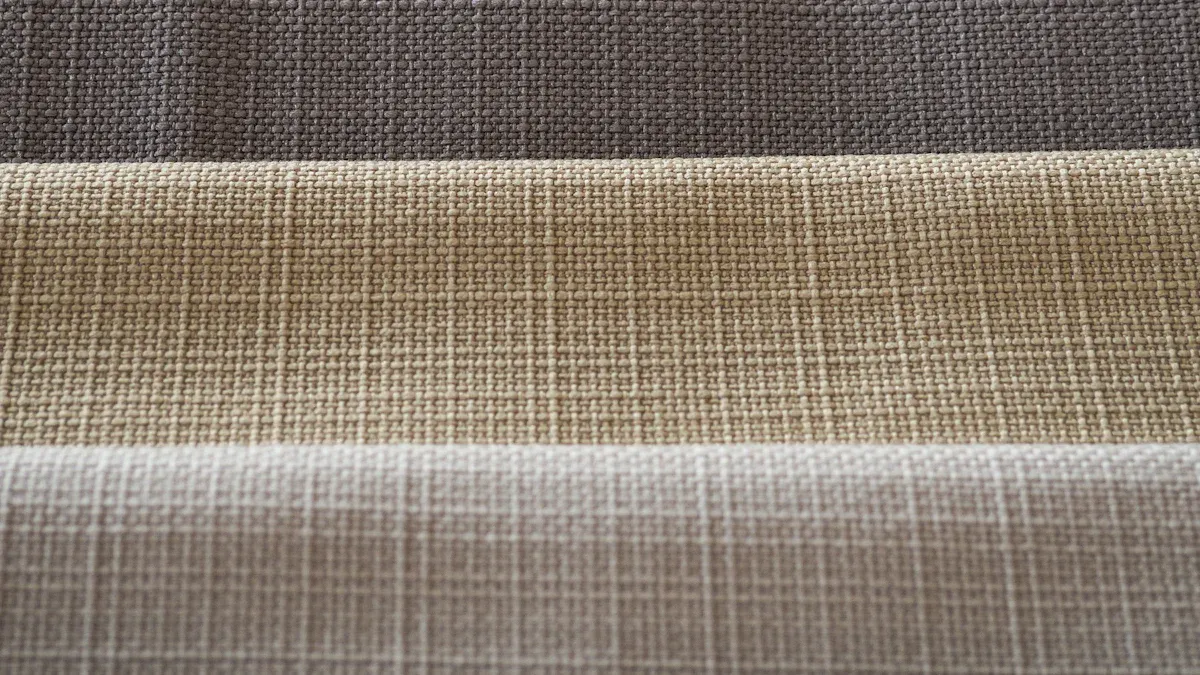
Common Tote Fabrics
When you start a tote bag project, you face many choices. The fabric you pick changes how much material you need and how your bag feels. You want a tote that lasts, looks good, and fits your style. Let’s look at some popular options:
| Fabric Type | Advantages | Disadvantages |
|---|---|---|
| Canvas | Excellent strength-to-weight ratio, durable, washable, good for printing | Environmental impact in production, more expensive to manufacture |
| Cotton | Smooth texture, washable, resilient, good for printing | Suitable for lighter items, may shrink when washed |
| Jute | Eco-friendly, resilient, cheap to produce | Lower longevity, hard to print on, difficult to clean |
Canvas stands out for its strength and durability. You can use it for heavy-duty bags. Cotton feels soft and works well for everyday totes, but it may shrink after washing. Jute is a great eco-friendly choice, but it does not last as long and can be hard to clean.
You also see denim and linen used for tote bags. Denim gives a rugged look and holds up well. Linen feels light and airy, perfect for summer. Each fabric has its own texture, weight, and durability. You should select your fabric based on how you plan to use your tote.
Shrinkage and Pre-Washing
You might wonder if you need to pre-wash your fabric. The answer is yes, especially for cotton and canvas. These fabrics shrink after washing, which can change your finished bag size. If you skip pre-washing, your tote might end up smaller than you planned.
Here’s a quick look at shrinkage rates:
| Fabric Direction | Shrinkage Percentage |
|---|---|
| Lengthwise | 7% |
| Crossgrain | 4.5% |
If you cut a 20cm square, you could lose up to 1cm in length after washing. That’s about 5%. Always add a little extra to your yardage to cover shrinkage. For most projects, buying 10% more fabric keeps you safe.
Tip: Wash and dry your fabric before you cut. This helps you avoid surprises later.
Pattern Matching
Do you love bold prints or stripes? Pattern matching makes your tote look professional, but it uses more fabric. You need extra material to line up designs at the seams. If you use a solid color, you can cut pieces close together and waste less fabric.
Here are some things to keep in mind:
- Large prints need more yardage for matching.
- Stripes and checks require careful cutting.
- Small patterns or solids let you use fabric more efficiently.
If you want perfect pattern alignment, plan for at least ¼ yard extra. Lay out your pieces before you cut to see how the design lines up.
Note: Pattern matching takes patience, but it makes your tote stand out!
Now you know how fabric type, shrinkage, and pattern matching affect your project. Make sure you plan ahead so your tote bag turns out just right.
Tips for Efficient Fabric Use
Cutting Layouts
You want to get the most out of your fabric when making a tote bag. Planning your cutting layout helps you save material and avoid mistakes. Here’s a simple way to do it:
- Grab a pencil and paper. Write down your measurements for each panel and gusset.
- Draw rectangles to show where each piece will go on the fabric. Mark the size and shape of every part.
- Subtract the size of your panels and gussets from the total fabric width. This shows you how much fabric you have left.
- Add a few extra inches to your plan. This covers small cutting errors, called kerf.
- Use the full width and length of your fabric. Adjust the gusset widths if you need to fit everything in.
- If you use old or repurposed fabric, measure and straighten the edges before you start cutting.
- Think about the direction of any patterns. If the design matters, line up your pieces. If not, focus on saving fabric.
Tip: Planning your layout before you cut helps you avoid running out of fabric and keeps your project stress-free.
Minimizing Waste
You can cut down on fabric waste with a few smart strategies. Check out this table for ideas that work in sewing rooms and factories:
| Strategy | Description |
|---|---|
| Optimizing Pattern Cutting | Use modern tools to cut waste by 10–22% compared to hand cutting. |
| Digital Pattern Making Solutions | Advanced nesting software maximizes fabric usage and reduces textile waste in cutting rooms. |
| Zero-Waste Cutting Techniques | Arrange patterns parallel to selvage edges and use digital markers for precise cutting. |
| Closed-Loop Production System | Reshape production into a circular system to keep materials in continuous use and reduce environmental impact. |
| Material Recovery Programs | Capture and process production waste effectively, using sorting systems to maintain quality. |
| Supplier Partnership Development | Build alliances with suppliers for sustainable materials and shared sustainability goals. |
You don’t need fancy machines at home, but you can still use some of these ideas. Lay out your pattern pieces close together. Cut along the selvage edge when possible. Save leftover bits for future projects.
Note: Every scrap you save means less waste and more value from your fabric.
Using Scraps
Don’t toss those leftover pieces! You can turn fabric scraps into useful parts for your tote bag or other crafts. Try these creative ideas:
- Layer two squares of nylon net and stitch around three sides. Use backstitches to make the seams strong.
- Draw a 2-inch grid on the net. Stuff the pockets with fabric scraps, arranging them in fun patterns.
- Pin the scraps in place. Stitch along the grid lines to hold everything together.
- Make patchwork bias binding. Trim larger scraps into 2-inch wide strips and sew them end to end.
- Create bag handles. Cut scraps into 3-inch wide pieces and join them until you reach the length you need.
- Finish your bag by stitching the net pieces together. Add the handles with your patchwork binding for a neat look.
Callout: Using scraps not only saves money, but also gives your tote bag a unique style. You help the planet by reducing waste, too!
Cuánta Tela Se Necesita Para Un Tote Bag
Fabric Needs in Spanish
Are you looking for information about tote bag fabric in Spanish? Maybe you want to share sewing tips with friends or family who speak Spanish. You might also want to search for “cuánta tela se necesita” online. If so, you’re in the right place. Let’s break down the basics so you can talk about tote bag projects in both English and Spanish.
When you ask, “How much fabric do you need for a tote bag?” in Spanish, you say:
¿Cuánta tela se necesita para hacer una bolsa tote?
You can use this phrase when you shop for fabric or chat with someone at a sewing store. If you want to explain the steps, try these simple sentences:
- Para una bolsa tote estándar, necesitas entre 0.75 y 1 yarda de tela de 54 pulgadas de ancho.
- Si quieres agregar forro, bolsillos o asas largas, compra un poco más de tela.
- Mide el ancho, alto y profundidad de tu bolsa antes de cortar la tela.
You can see that the process is very similar in both languages. You measure, plan, and add extra fabric for features like lining or pockets. If you want to help someone who speaks Spanish, just translate your measurements and tips.
Tip: If you’re sewing with a friend who speaks Spanish, use both languages for your notes. This makes the project more fun and helps everyone learn new words!
Quick Reference Table
Here’s a handy table you can use or share. It shows the fabric needs for tote bags in English. You’ll see the size, the amount of fabric, and a quick note about extra features.
| Bag Size | Dimensions (Width x Height x Depth) | Fabric Needed (width 44/45″) | Note |
|---|---|---|---|
| Small | 12 x 14 x 4 inches | ~ 1 yard | For light items |
| Medium | 15 x 16 x 5 inches | ~ 1.25 yards | Everyday use |
| Large | 15 x 18 x 8 inches | ~ 1.5 yards | For shopping or gym |
| Extra Large | 20 x 16 x 8 inches | up to 2 yards | For beach or travel |
If you want to add lining, pockets, or longer handles, add 0.25–0.5 yards more. This helps you avoid running out of fabric.
You can print this table or save it on your phone. Next time you visit a fabric store, just show the table and ask for the amount you need. You’ll feel confident and ready to start your tote bag project.
Callout: Sharing sewing tips in English helps you connect with more people. You can teach, learn, and make beautiful tote bags together!
Conclusion
You now understand how much fabric you need for any tote bag. Look at this table to help you choose the best fabric weight for your project:
| Fabric Weight Category | Description | Use Cases |
|---|---|---|
| Lightweight (3-4 oz) | Easy to carry, good for free gifts | Brochures, light things |
| Medium-weight (5-7 oz) | Strong and easy to move around | Books, daily stuff |
| Heavyweight (10+ oz) | Very tough and sturdy | Groceries, laptops |
Use simple tables and easy math to plan your fabric. This helps you save time and avoid errors. If you want special tote bags, our OEM and ODM services offer cool designs, lower prices, and quick shipping.
FAQ
How much fabric do I need for a lined tote bag?
You usually need the same amount of fabric for the lining as you do for the outer bag. If your tote uses 1 yard for the outside, grab another yard for the lining. Always buy a little extra for mistakes.
Can I use scraps for tote bag handles?
Yes! You can piece together fabric scraps for handles. Just make sure the strips are strong and wide enough. Sew them together, press the seams flat, and reinforce with topstitching for extra durability.
What’s the best fabric for a sturdy tote bag?
Canvas works great for sturdy totes. Denim and heavyweight cotton also hold up well. If you want a lightweight bag, try quilting cotton. For heavy loads, stick with canvas or denim.
Do I need interfacing for my tote bag?
You don’t have to use interfacing, but it helps your bag keep its shape. If you want a floppy, casual tote, skip it. For a structured look, add medium or heavy interfacing between the layers.
How do I calculate fabric for custom tote sizes?
Measure your desired width, height, and depth. Double the height for front and back panels. Add seam allowances. Don’t forget extra for handles, lining, or pockets. Write down your numbers before you cut.
Should I pre-wash my fabric before sewing?
Yes, you should pre-wash your fabric. This prevents shrinkage after you sew your tote. Wash and dry the fabric as you would the finished bag. Press it flat before cutting.
Can I make a tote bag without a pattern?
Absolutely! You can draw simple rectangles for the body and handles. Use a ruler and chalk to mark your fabric. Cut, sew, and you have a custom tote. Patterns help, but you don’t need one for basic designs.
How much extra fabric should I buy for mistakes?
Buy at least 10% more fabric than your calculations. This covers errors, shrinkage, or last-minute changes. It’s always better to have a little extra than to run out mid-project.

